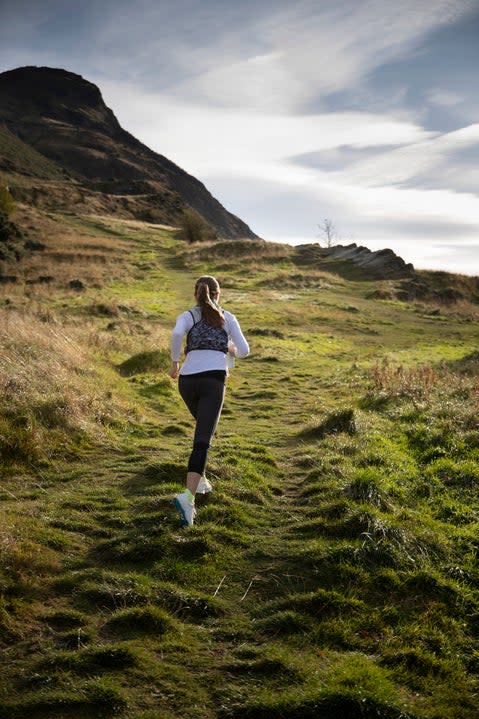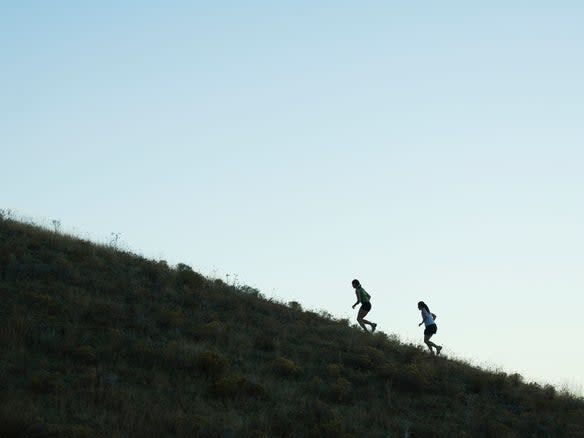How To Use Hill Intervals For Stronger Climbing
The famous quote from Olympic gold medalist Frank Shorter is that "hills are speedwork in disguise." That sentiment is undoubtedly true--strong hill running will make for a faster runner. But it's only true to a point. Hill work at the exclusion of speed development on variable terrain will probably result in a slower runner over time than would be possible with a well-rounded training plan.
There's nothing groundbreaking about that statement. From Coach Arthur Lydiard in the 1960s to Renato Canova today, hill intervals are a key component of most training plans, usually to support adaptations that allow for faster running other times. For many training systems focused on flat speed, that means hills early in a training cycle as an introduction to workouts (often as short hill intervals), plus as a supplement later in training cycles to continue developing efficient muscular output (often as hill strides or bounds, with possible periodic reintroduction of longer intervals).
For trail runners, the racing demands are different, so the exact placement of hill intervals in a training cycle may vary, but the principle remains the same. The goal of hill intervals is to develop a positive feedback loop with aerobic development (easy runs, long runs, tempos) and speed/strength development (strides, workouts on flats, workouts on hills), so that the fitness gains can be compounded over time.
Should you do hill intervals? Yes. Should you do them for every workout? Probably not (but that's not a universal rule, particularly for skyrunners). Let's outline some considerations so you can understand how hills fit in with your unique background.
Should you do hill intervals? Yes. Should you do them for every workout? Probably not (but that's not a universal rule, particularly for skyrunners).
RELATED: The Best Way To Build Uphill Speed
Hills have decreased impact force.
A 2005 study in the Journal of Biomechanics found that uphill running decreased impact forces while increasing parallel propulsive peaks by 75 percent. What that means is that doing harder efforts uphill will likely decrease the risk of overuse injuries associated with impact, plus it may result in less breakdown short of injury, allowing an athlete to train more consistently day-to-day.
Application: Mark Tatum, a 59-year-old mountain-running superstar, does most of his high-intensity work on uphills in order to avoid breakdown. Aging athletes and those who deal with persistent soreness would likely benefit from moving some of their workouts to hills.
At the other end of the spectrum, obstacle-course-racing world champion Nicole Mericle dealt with overuse injuries early in her running career, and many of those issues subsided with a higher proportion of hills in training.
Climbing involves different muscle patterns that need to be trained.
A 2019 study in the European Journal of Applied Physiology had a fascinating finding: uphill, downhill and level-ground running economy were strongly correlated. That's weird, since as stated by the authors, the biomechanical demands vary considerably. They hypothesized that the reason for the correlation was that training normally involved enough ups, downs and flats so that fitness distributed across the different biomechanical demands. However, implied in that discussion is that it's still necessary to climb to be good at climbing.
As outlined in a 2017 review in Sports Medicine, uphill running--especially up steeper grades--involves increased internal mechanical work, with more mid-foot landing and more work by the lower limbs. Overall, that means greater muscular activity.
So the form is different and the musculoskeletal demands are different. You know that old saying that you shouldn't do anything new on race day? Well, you probably shouldn't be doing climbing you aren't used to on race day either. While vert is probably not the best proxy for long-term development of speed (and may not even be real), it's absolutely essential if you want to be a better climber on steep grades.
RELATED: 8 Workouts To Improve Uphill Running
Application: The steeper the grade, the more climbing-specific practice becomes important. Unlike road or track athletes coached by Lydiard or Canova, most trail runners have events with substantial vert. Applying the principle that training should be more specific closer to events, hill intervals may be more important closer to race day.
A good example might be Jason Schlarb, whose training looks a bit like a diamond. At one pointy end, he starts training cycles with short hill intervals and hill strides. In the middle, he works on traditional speed development, after which a Lydiard/Canova system would go into a specific phase. For Schlarb, his specific phase doesn't involve track intervals at race pace, but hill climbs and descents that simulate some of the terrain demands at a race like Hardrock or UTMB.
RELATED: 8-Week Road Marathon Training Plan For Trail Runners

Hill intervals may involve higher output, depending on approach.
That Sports Medicine review and some of the articles it cited describe an increase in power output during uphill running (under some conditions). In practice, it's likely dependent on the athlete, the type of hill, the effort and lots of other variables.
What I have seen in coaching is that athletes often have higher outputs on short hills relative to the same duration on flats, but that difference vanishes on longer hills when all but the fittest athletes start to compromise form as their muscles fatigue (particularly if the uphills have rocks or other technical elements that reduce output).
Some of that can be trained away with climbing practice, but I imagine there is an inflection point where a good hill interval becomes a graceless slog, which varies a ton based on the athlete and their background.
Application: I have generally seen that athletes start to reduce output relative to flat/rolling terrain around three to five minutes for hill intervals, or 20 to 30 minutes for hill-climb tempos. That's highly individual-dependent, so just pay attention to how you feel and ignore this discussion if it doesn't apply to you (or if you use Strava's grade-adjusted pace/power meters, look at what the numbers say).
Basically, avoid having your workouts be slogs. The goal of workouts is to use less energy at a given output, not just to use lots of energy. If you find your hill intervals suffering in quality as an interval progresses or as a workout goes on, do shorter hills or fewer intervals.
RELATED: Coach Roche's 8 Favorite Hill Workouts
Hill intervals may improve running economy on all terrain.
Improved uphill running economy will usually correlate with better flat and downhill running economy. That statement is subject to lots of caveats, but as the great Frank Shorter said: Getting stronger on hills will generally make you faster on flats and downs.
Application: Don't shy away from hills. But if you get to flat ground and feel unnatural, you might want to get a bit more shy.
On hill intervals, some athletes may go too hard for their training goals.
The flipside of the increased output discussion above is that athletes may overexert themselves relative to their perceived exertion. Intervals are rarely designed to be all out, i.e. with each one ending with extreme fatigue and a need to stop at the end.
That's easier to internalize for many athletes on rolling terrain than on uphills. In practice, that might mean using anaerobic energy systems on hill intervals, which has a time and place. But for most distance runners, that time is rarely, and that place is probably not here.
Application: When you do hill intervals, err on the side of a more relaxed start, working into the effort and making sure your perceived effort is well-calibrated.
RELATED: Run Faster On Trails With Power Hill Strides

6 Hill Workout Ideas
Let's review some quick-hitter workouts you can do almost any time in a training cycle, even if there isn't a lot of planning involved. One or two workouts a week (on hills or other terrain) is ideal, with plenty of easy running for a well-rounded training plan.
When choosing the gradient for hill workouts, I like athletes to make sure they are using good form. That usually means you don't want the hill to be straight up unless you are training for straight-up races, since it'll be harder to maintain output on steeper terrain for many athletes (though shorter hill strides can be steeper). A good sweet spot is an average of six-to-10-percent grade, with shallower good for speed, and steeper better for adaptations specific to that terrain.
4-6 x 10-30 second hills fast with 1-2 minutes easy running recovery near the end of an easy run
Short hill strides are a staple of many training programs, likely because of their role in improving running economy. They involve minimal stress, so you can do them once or twice a week.
6-10 x 1 min hills hard with 2 minutes easy to easy/moderate recovery
Most athletes will gravitate toward VO2 max on these shorter hill intervals, an effort range that coincides with positive adaptations for many athletes (especially beginners or athletes at the start of training cycles).
5 x 2 minute hills moderately hard with 3 minutes easy/moderate run back recovery
Easy/moderate float recovery between intervals works on clearance of fatigue byproducts, providing an efficient stimulus that will overlap with some of the demands of race day.
5 x 3 minute hills moderately hard with run back down recovery
Three-minute hills are around the limit I have seen for many athletes to get a quality workout without a substantial drop in output. This workout is tough, and it's a good one to do periodically in a training cycle for a dose of suffering and high-end aerobic development.
20-30 minute hill climb tempo
Climbs are great for threshold work as long as your muscular endurance is high enough to sustain a quality effort over the course of the tempo. 20 minutes is a good sweet-spot on the trails or treadmill.
RELATED: Get Stronger On Hills (Even if You Live Somewhere Flat)
A basic summary of the discussion is that when it comes to your hard workouts, it's good to mix it up. If you want to excel at flatter running, hill intervals are great early in training cycles to improve muscular output and aerobic capacity with reduced impact, with hill strides having a role throughout a training cycle.
If you want to excel in trail races that involve climbing, hill intervals have a bigger role throughout a training cycle, but make sure you also develop your speed. That can be as simple as doing a set of fast strides at the end of a hill workout.
If your goal is skyracing, you can rely more on hill intervals, with the caveat that long-term development of climbing ability may eventually require developing level-ground running economy too.
I suddenly realized that this article could have just been the last three paragraphs. Well, if you got this far, you worked your endurance and toughness. And when it comes to climbing, that might be most important of all.
David Roche partners with runners of all abilities through his coaching service, Some Work, All Play. With Megan Roche, M.D., he hosts the Some Work, All Play podcast on running (and other things), and they wrote a book called The Happy Runner.
